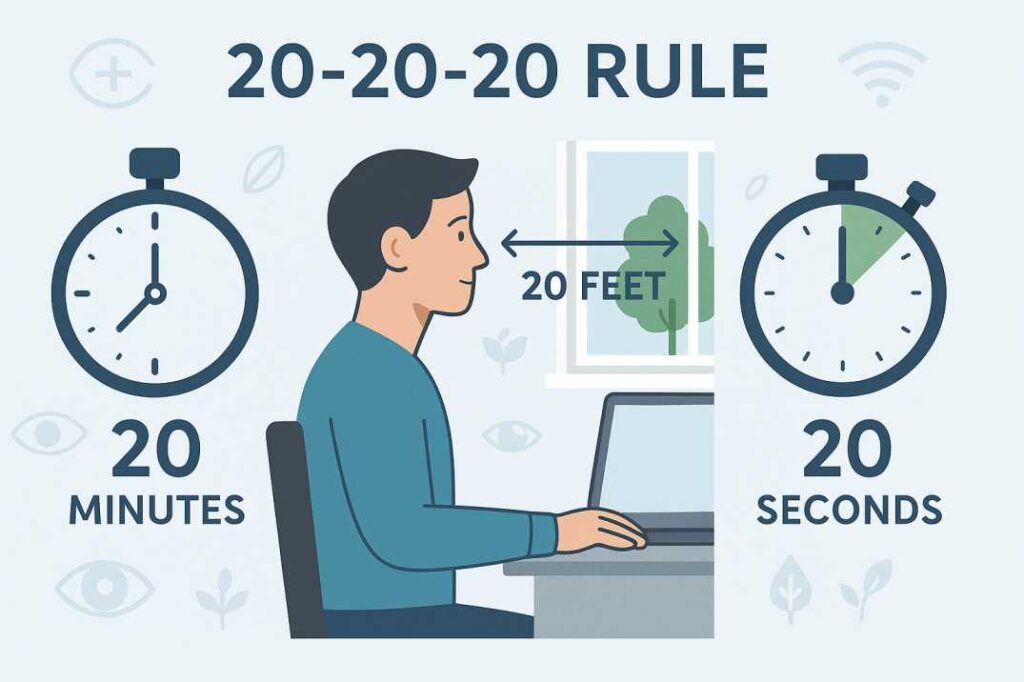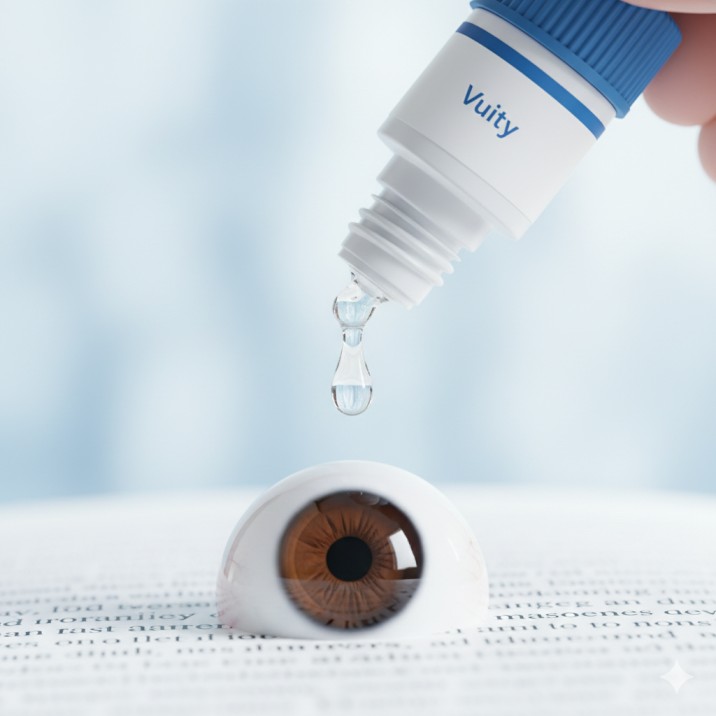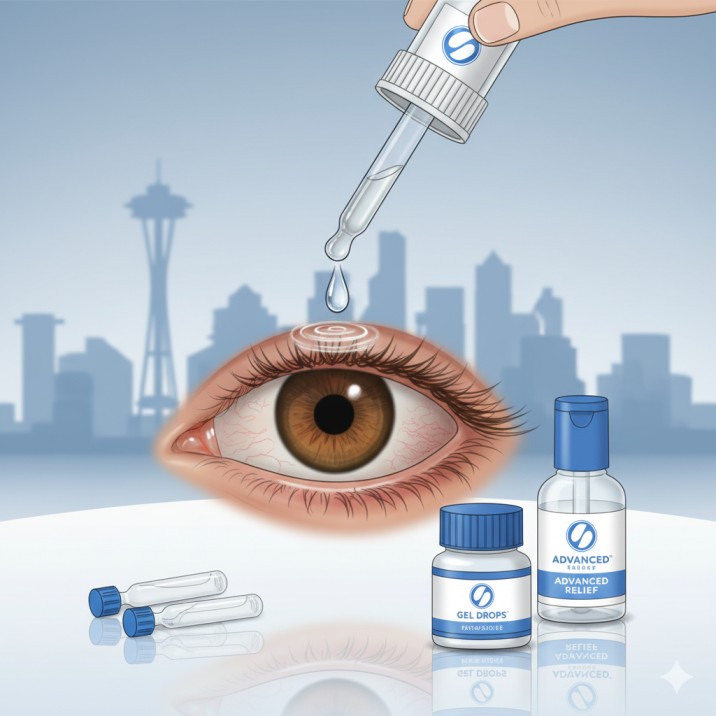Eye Strain Headaches: When to See an Eye Doctor | Seattle Guide
Your Complete Guide to Digital Eye Strain Relief in Seattle
Bottom Line Up Front: Eye strain headaches from screen use affect 62.6% to 78% of digital device users according to recent 2024 studies. At the same time, many cases respond to lifestyle interventions like the 20-20-20 rule and ergonomic adjustments, and persistent symptoms lasting beyond 24 hours warrant a comprehensive eye examination to identify underlying conditions and ensure optimal visual health.
In our increasingly digital world, eye strain headaches have emerged as an occupational hazard for millions of professionals. That familiar dull, throbbing sensation behind your eyes after extended computer sessions isn’t merely fatigue—it’s a manifestation of what eye care specialists term digital eye strain, a condition affecting the majority of screen users worldwide.
At Cannon EyeCare in Seattle, we observe this phenomenon daily among patients across industries, from tech professionals to remote workers. The question isn’t whether digital eye strain will affect you, but rather when its symptoms will progress beyond typical discomfort to warrant professional intervention. This comprehensive guide elucidates the mechanisms behind eye strain headaches, identifies critical warning signs, and provides evidence-based guidance for navigating your eye health decisions in the Pacific Northwest’s digitally intensive work environment.
Understanding Eye Strain Headaches: Beyond Simple Fatigue
Eye strain headaches constitute a distinct category of cephalgia that manifests when ocular muscles experience fatigue from sustained focusing activities. Unlike migraine or tension-type headaches, eye strain headaches present with characteristic features that facilitate differential diagnosis and targeted intervention.
Diagnostic Criteria for Eye Strain Headaches:
- Temporal relationship to prolonged visual tasks, particularly digital screen engagement
- Localization as a pressure or aching sensation posterior to the globes
- Resolution or significant improvement with ocular rest
- Associated ocular surface symptoms, including dryness and irritation
- Absence of gastrointestinal disturbances, typically associated with migraine
The Pathophysiology of Headaches from Screen Use
Digital display interaction challenges the visual system through multiple mechanisms that collectively precipitate eye strain and subsequent headaches from screen use. Contemporary research demonstrates that digital eye strain affects approximately 66% of knowledge workers, establishing it as a primary occupational health concern in developed economies.
The ocular system encounters increased demands during screen viewing due to:
- Accommodative stress: Pixelated text requires continuous micro-adjustments of the crystalline lens
- Reduced blink frequency: Screen users demonstrate significantly decreased blink rates (3-7 blinks per minute versus the physiological norm of 14-16 blinks)
- High-energy visible light exposure: Blue light wavelengths (400-490nm) may contribute to photoreceptor fatigue
- Suboptimal viewing ergonomics: Non-physiological screen positioning necessitates compensatory extraocular muscle activation
The Epidemiology of Digital Eye Strain: A Growing Public Health Concern
Contemporary surveillance data reveals the remarkable prevalence of digital eye strain across demographic groups. Recent investigations from 2024 document digital eye strain rates ranging from 62.6% to 78% among digital device users, with elevated prevalence specifically documented during the COVID-19 pandemic when remote work modalities and digital learning platforms became ubiquitous. A comprehensive meta-analysis examining 103 cross-sectional studies encompassing 66,577 participants established that approximately 66% of computer users manifest some degree of computer vision syndrome.
Prevalence Distribution by Demographics (2024 Data):
- Adult populations: 62.6% to 78% symptom prevalence among digital device users
- Working professionals (UK/Ireland): 62.6% confirmed prevalence in landmark 2024 investigation
- Pediatric populations during the pandemic: 50-60% experienced digital eye strain manifestations
- Geriatric populations (≥60 years): 51.6% prevalence with documented associations to ocular surface disease
- Contact lens users: Elevated risk profile secondary to additional ocular surface perturbation
Digital Eye Strain: A Multisystem Syndrome
While headaches from screen use represent the most recognized manifestation, digital eye strain encompasses a constellation of symptoms affecting multiple physiological systems and significantly impacting occupational performance and quality of life:
Ocular manifestations:
- Transient refractive blur with difficulty accommodating between viewing distances
- Diplopia in severe cases, typically attributed to convergence insufficiency
- Photophobia and increased sensitivity to ambient illumination
Ocular surface manifestations:
- Xerophthalmia with associated foreign body sensation
- Conjunctival hyperemia and ocular burning
- Paradoxical hyperlacrimation as a compensatory response
- Eyelid erythema and periocular inflammation
Systemic manifestations:
- Cervical and trapezius muscle tension secondary to postural compensation
- Generalized fatigue and decreased cognitive performance
- Impaired concentration and reduced task efficiency
- Elevated stress response markers
Clinical Assessment: When to Seek Professional Evaluation
While transient ocular fatigue following screen exposure represents a physiological response, certain symptom patterns necessitate professional ophthalmic assessment. At Cannon EyeCare’s University Village and Pike Place Market facilities, we employ standardized criteria for determining when symptoms warrant comprehensive evaluation:
Urgent Referral Criteria
Immediate professional consultation is indicated for:
- Acute onset of severe cephalgia with concurrent visual field defects
- Persistent binocular diplopia unresolved by rest
- Severe ocular pain refractory to conservative measures
- Acute visual acuity loss or dramatic refractive changes
- Cephalgia with associated nausea, vomiting, and photophobia
- Clinical signs suggestive of angle-closure glaucoma (ocular pain, corneal edema, fixed mid-dilated pupil)
Routine Evaluation Indicators
Schedule a comprehensive examination for:
- Eye strain headaches persisting beyond 24 hours despite intervention
- Progressive symptom severity or frequency
- Persistent refractive blur unresponsive to accommodative rest
- Ocular surface symptoms refractory to over-the-counter lubricants
- Symptoms significantly impacting occupational or recreational activities
- New-onset cephalgia in patients over 50 years
Warning Signs of Underlying Eye Conditions
Sometimes, what appears to be simple eye strain may indicate more serious conditions:
Uncorrected refractive errors:
- Squinting to see clearly
- Holding reading material at arm’s length
- Difficulty seeing road signs while driving
- Frequent prescription changes
- Tilting head to read
- Covering one eye for comfort
- Difficulty with depth perception
- Motion sickness while reading in cars
Dry eye disease:
- Symptoms are worse in air-conditioned environments
- Gritty sensation that persists throughout the day
- Difficulty wearing contact lenses comfortably
- Excessive tearing (paradoxical response to dryness)
The Professional Evaluation: What to Expect During Your Eye Exam
When you visit an eye care professional for eye strain concerns, expect a comprehensive evaluation that goes beyond checking your vision. At Cannon EyeCare’s Seattle locations, our thorough approach includes:
Comprehensive History Taking
Your eye doctor will inquire about:
- Duration and frequency of symptoms
- Specific activities that trigger discomfort
- Work environment and screen habits
- Previous eye health history
- Current medications and health conditions
- Family history of eye problems
Detailed Vision Assessment
Visual acuity testing: Checking clarity of vision at various distances. Refraction: Determining if you need vision correction or a prescription update. Binocular vision evaluation: Assessing how well your eyes work together.er Accommodation testing: Measuring your eyes’ focusing ability. Eye movement assessment: Checking for muscle imbalances
Ocular Health Examination
External examination: Evaluating eyelids, lashes, and surrounding structure. Tear film assessment: Testing tear production and quality.ty Anterior segment evaluation: Examining cornea, conjunctiva, and lens. Posterior segment examination: Checking retina, optic nerve, and blood vessels. Intraocular pressure measurement: Screening for glaucoma
Specialized Testing When Indicated
Depending on your symptoms, additional testing might include:
- Dry eye evaluation: Tear breakup time, osmolarity testing
- Visual field testing: Checking peripheral vision
- Optic nerve imaging: Advanced scanning for glaucoma detection
- Retinal photography: Documenting baseline eye health
Evidence-Based Management Protocols
Contemporary peer-reviewed literature provides robust evidence for digital eye strain management strategies. Three seminal investigations from 2024-2025 establish the foundation for current therapeutic recommendations:
Key Research Findings
Investigation 1: UK-Ireland Digital Eye Strain Assessment (2024) This landmark epidemiological study examined working adults across the United Kingdom and Ireland, documenting a 62.6% prevalence of digital eye strain among digital device users. The investigation revealed average daily device utilization of 9.7 hours, with 94.3% of participants reporting musculoskeletal symptoms and 89.5% manifesting ocular symptoms.
Investigation 2: Pediatric Digital Eye Strain Assessment (Palestine, 2025) A prospective cross-sectional study involving 492 school-aged participants (11-18 years) employed the validated Computer Vision Syndrome Questionnaire to assess digital eyestrain prevalence. This investigation demonstrated the expanding impact of digital devices on developing visual systems and emphasized the critical need for early intervention protocols across age demographics.
Investigation 3: COVID-19 Pandemic Impact Meta-Analysis (2024) A systematic review and meta-analysis published in BMC Public Health examined computer vision syndrome prevalence during pandemic lockdown periods across multiple international cohorts. The analysis documented digital eye strain prevalence reaching 78% in certain populations, with India demonstrating particularly elevated rates (78%) compared to pre-pandemic baselines (64.3%).
The 20-20-20 Protocol: Evidence-Based Prevention
The most extensively validated intervention for preventing eye strain headaches involves the systematic implementation of the 20-20-20 protocol: every 20 minutes, redirect visual attention to an object positioned at least 20 feet distant for a minimum duration of 20 seconds. This evidence-based practice facilitates accommodative relaxation and ciliary muscle recovery.
Implementation strategies:
- Utilization of automated reminder systems with 20-minute intervals
- Integration with existing productivity applications
- Incorporation into telephonic communications and virtual meetings
- Combination with brief cervical and shoulder mobilization exercises
Environmental Optimization Protocols
Display positioning specifications:
- Monitor placement at 50-70 cm (20-26 inches) from the user
- Screen center positioned at or below horizontal eye level
- 10-20 degree posterior tilt to minimize cervical hyperextension
Illumination management:
- Ambient lighting is maintained at approximately 50% of the display luminance
- Perpendicular screen orientation relative to natural light sources
- Implementation of adjustable task lighting systems
- Anti-reflective screen filters for high-glare environments
Display configuration optimization:
- Font size adjustment to minimize accommodative demand
- Contrast enhancement for comfortable discrimination
- Dark mode utilization in reduced ambient lighting
- Brightness calibration to match environmental conditions
Professional Therapeutic Interventions
When conservative environmental modifications prove insufficient, several evidence-based professional treatments demonstrate efficacy:
Optical correction modalities:
- Computer-specific spectacles with anti-reflective coatings
- Blue light filtering lenses (emerging evidence suggests modest benefit)
- Prismatic correction for binocular vision dysfunction
- Occupational progressive addition lenses optimized for intermediate viewing distances
Medical management approaches:
- Topical cyclosporine or lifitegrast for inflammatory dry eye
- Punctal occlusion procedures for aqueous tear deficiency
- Anti-inflammatory medications for acute exacerbations
- Vision therapy protocols for accommodative and vergence disorders
Advanced therapeutic modalities:
- Intense Pulsed Light (IPL) therapy for meibomian gland dysfunction
- Thermal radiofrequency treatment for posterior blepharitis
- Neurolens prismatic technology for trigeminal neuralgia associated with binocular vision dysfunction
- Specialty contact lens designs for complex refractive cases
Prevention Strategies: Building Healthy Digital Habits
Workplace Ergonomics
Creating an eye-friendly workspace involves more than just proper screen placement:
Chair and desk setup:
- Feet flat on the floor or footrest
- Thighs parallel to the ground
- Back supported with natural lumbar curve
- Arms at a 90-degree angle when typing
Environmental factors:
- Humidity levels between 40-60%
- Good air circulation to prevent dry eyes
- Temperature control to avoid excessive air conditioning
- Plants or humidifiers to add moisture
Lifestyle Modifications
Sleep hygiene:
- Avoid screens 1-2 hours before bedtime
- Use night mode settings after sunset
- Maintain a consistent sleep schedule
- Create a screen-free bedroom environment
Nutrition for eye health:
- Omega-3 fatty acids for tear production
- Antioxidants (vitamins C and E) for cellular protection
- Adequate hydration throughout the day
- Limiting caffeine, which can exacerbate dry eyes
Exercise and movement:
- Regular neck and shoulder stretches
- Eye movement exercises
- Taking walking breaks to reset focus
- Practicing the 20-20-20 rule consistently
Special Considerations for Different Age Groups
Children and Teenagers
Young people are particularly vulnerable to digital eye strain due to:
- Rapidly developing visual systems
- Increased screen time for education and entertainment
- Less awareness of symptoms
- Poor ergonomic habits
Parental guidance strategies:
- Model healthy screen habits
- Enforce regular breaks during online learning
- Monitor symptoms and seek early intervention
- Create tech-free zones and times
Adults in Their 40s and Beyond
As we age, several factors increase susceptibility to eye strain:
- Presbyopia (age-related focusing difficulty)
- Reduced tear production
- Increased likelihood of underlying eye conditions
- Medication side effects affecting vision
Age-specific recommendations:
- Annual comprehensive eye exams
- Consider progressive lenses for computer work
- Monitor for signs of glaucoma and macular degeneration
- Address dry eye symptoms promptly
Contact Lens Wearers
Digital device users who wear contacts face additional challenges:
- Reduced blink rates leading to lens dehydration
- Increased protein deposits on the lenses
- Higher risk of eye infections
- Comfort issues during extended wear
Contact lens strategies:
- Use rewetting drops designed for contacts
- Consider daily disposable lenses for computer work
- Take breaks from lens wear when possible
- Discuss specialty lenses with your eye care provider
When Home Remedies Aren’t Enough: The Role of Professional Care
Recognizing Treatment Limitations
While many cases of digital eye strain respond well to lifestyle modifications, some situations require professional intervention:
Persistent symptoms despite proper habits:
- Headaches from screen use continue after implementing the 20-20-20 rule
- Dry eye symptoms are not improving with over-the-counter drops
- Vision problems affecting work performance
- Sleep disruption due to eye discomfort
Underlying conditions requiring treatment:
- Uncorrected refractive errors
- Binocular vision dysfunction
- Chronic dry eye disease
- Computer-related vision syndrome
The Value of Comprehensive Eye Care
Regular eye examinations provide benefits beyond addressing immediate symptoms:
Early detection of serious conditions:
- Glaucoma (leading cause of blindness)
- Diabetic retinopathy
- Macular degeneration
- Retinal detachment
Optimization of visual function:
- Precise vision correction
- Identification of binocular vision issues
- Assessment of accommodation problems
- Customized treatment plans
Long-term eye health monitoring:
- Baseline measurements for future comparison
- Risk factor assessment
- Preventive care recommendations
- Medication monitoring for side effects
Technology Solutions and Emerging Treatments
Software and App-Based Interventions
Blue light management:
- F.lux for automatic color temperature adjustment
- Built-in night mode on devices
- Blue light filtering apps
- Scheduled screen dimming
Break reminder systems:
- EyeCare apps with customizable timers
- Computer-based reminder software
- Smartwatch notifications
- Productivity apps incorporating eye breaks
Innovative Treatment Approaches
Neurolens technology: Recent advances in lens technology address eye misalignment that contributes to digital eye strain. The lenses work by reducing pressure on the trigeminal nerve, which can become overstimulated due to eye misalignment, leading to symptoms such as headaches, eye strain, dry eyes, and neck and shoulder pain.
Advanced dry eye treatments:
- Thermal pulsation therapy
- Intense pulsed light (IPL)
- Radiofrequency treatment
- Autologous serum tears
Vision therapy programs: Customized exercise programs to improve:
- Eye coordination
- Focusing flexibility
- Visual processing
- Binocular vision skills
Creating Your Personal Action Plan for Eye Strain Headaches
Step 1: Symptom Assessment
Track your symptoms for one week:
- Time-of-day headaches from screen use occur
- Activities that trigger discomfort
- Duration and severity of eye strain headaches
- Associated symptoms (dry eyes, neck pain)
- Factors that provide relief
Step 2: Environment Optimization
Immediate changes you can make:
- Adjust screen position and lighting
- Implement the 20-20-20 rule
- Modify text size and contrast
- Address ergonomic issues
Step 3: Professional Evaluation Timeline
Schedule an eye exam if:
- Symptoms persist after one week of modifications
- You haven’t had an eye exam in over two years
- You experience any red flag symptoms
- Your symptoms interfere with work or daily life
Step 4: Long-term Management
Develop sustainable habits:
- Regular eye exams (annually or as recommended)
- Consistent implementation of preventive measures
- Monitor changes in symptoms
- Stay informed about new treatment options
Additional Resources & Citations
For readers seeking to deepen their understanding of digital eye strain and eye health, we recommend these authoritative sources that informed this comprehensive guide:
1. Computer Vision Syndrome: Symptoms, Treatment & Prevention – Cleveland Clinic
Link: https://my.clevelandclinic.org/health/diseases/24802-computer-vision-syndrome
Key Insights: This medical resource provides detailed information on the clinical aspects of computer vision syndrome, including the finding that digital eye strain affects up to 78% of adults during the pandemic period. The Cleveland Clinic’s research emphasizes the importance of proper screen ergonomics and the 20-20-20 rule for prevention.
2. Digital Eye Strain- A Comprehensive Review – PMC (PubMed Central)
Link: https://pmc.ncbi.nlm.nih.gov/articles/PMC9434525/
Key Insights: This peer-reviewed, comprehensive review, published in 2022, provides an extensive analysis of digital eye strain prevalence, ranging from 5-65% pre-COVID to 50-60% in children during the pandemic. The study offers crucial insights into the pathophysiology of varied manifestations and evidence-based management options that inform current treatment protocols.
3. Computer Vision Syndrome (Digital Eye Strain) – American Optometric Association
Link: https://www.aoa.org/healthy-eyes/eye-and-vision-conditions/computer-vision-syndrome
Key Insights: The AOA’s official guidelines define computer vision syndrome as eye and vision-related problems resulting from prolonged digital device use. This authoritative source provides professional recommendations for diagnosis, treatment, and prevention strategies that eye care professionals use nationwide.
Note: These resources represent the gold standard in digital eye strain research and clinical guidance. For the most current information and personalized care recommendations, consult with a qualified eye care professional who can assess your individual needs and symptoms.
Take Action Today: Schedule Your Seattle Eye Examination
Eye strain headaches from screen use represent a significant occupational health challenge in contemporary digital workplaces, yet they need not compromise professional productivity or personal well-being. Understanding the clinical indicators that necessitate professional intervention proves essential for maintaining optimal ocular health and preventing progression to more complex conditions.
The clinical evidence demonstrates that while conservative lifestyle modifications effectively address many presentations of digital eye strain, persistent or progressive symptoms warrant comprehensive ophthalmic evaluation. Early professional intervention facilitates identification of underlying conditions, optimization of visual function, and implementation of targeted therapeutic protocols that substantially enhance quality of life outcomes.
The modern digital environment places unprecedented demands on the human visual system. These demands necessitate the same systematic attention and professional care afforded to other aspects of health maintenance. When eye strain headaches prove refractory to standard conservative measures, professional consultation should be pursued without delay.
At Cannon EyeCare, we recognize the distinctive challenges confronting Seattle’s technology professionals and digital workforce. Our comprehensive diagnostic approach integrates advanced imaging technology with individualized treatment protocols designed to address the fundamental causes of your symptoms. In the realm of vision care, clinical excellence admits no compromise.
Ready to achieve definitive relief from eye strain headaches? Contact Cannon EyeCare today to schedule your comprehensive ophthalmic evaluation at our University Village or Pike Place Market locations. Your visual comfort—and professional performance—depend on it.
FAQs
-
Eye strain headaches typically include tired, sore eyes, temporary blurred vision, light sensitivity, and mild forehead or temple pain.




